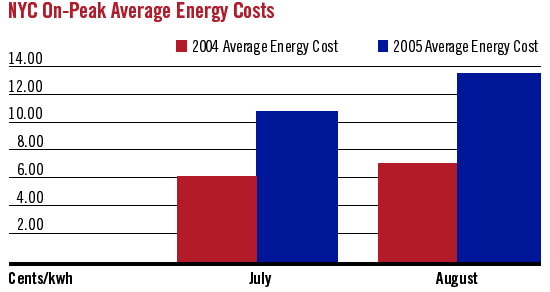Electricity Outlook 2010-2025
Overview
New York City will need between 6,000 to 7,000 megawatts (MW) of new electricity resources over the next twenty years to satisfy the demands of the comprehensive residential and commercial development proposed Citywide, and to support continued economic growth and increasing population. New York City will not be able to assure its competitive position and achieve projected growth without new electric generation capacity, transmission and distributed resources. A robust and reliable energy infrastructure is essential for the future economic well being of the City.
A critical threshold looms for the years 2010-2015, when projected electric capacity requirements for New York City and Long Island could fall “substantially below” the Statewide criteria, according to the December 2005 report of the New York Independent System Operator (NYISO). Because it can take three-to-five years to permit and build a new power plant, to assure that sufficient power is available for 2010-2015:
- Financing issues must be resolved to allow construction of two already approved projects that could provide over 1,000 MW of power;
- Construction of new power plants, transmission lines and distribution infrastructure must begin as soon as possible;
- Energy efficiency investments must be increased;
- Planned retirement of older plants may have to be delayed.
If New York City is to accommodate the multiple new office, commercial and residential projects now planned or proposed throughout the five boroughs, and have sufficient power for the increased levels of employment and population forecast for the City over the next twenty years, new electric resources, together with new infrastructure to carry and distribute that
electricity within the City, will be needed between now and 2025. Investments like these, in energy-efficient buildings and improved technologies for power plants, will also improve the City’s air quality. Energy-efficiency measures can help mitigate the total need, and will be
necessary to help meet the immediate capacity requirements of 2010-2015.
But additional generation and transmission facilities also will be needed to meet most of New York City’s long-term electricity needs. The bulk of these facilities must be located ‘In-City’; within or nearby the five boroughs. New York State’s Article X licensing process expired in December 2002. New York State must urgently pass new-- or reinstate previous-- approval mechanisms for additional generating facilities so that power can be available when needed and the City’s expected growth can be supported.
The exceptionally high electricity usage during the summer of 2005-- one of the hottest summers on record-- underscores the impact of strong increases in demand by the City’s businesses and residents. On July 27, peak demand in New York City reached 11,304 MW, an all time high, and in August more electricity was used than in any previous single month.1 This sharp increase in demand, coupled with the electric supply needed to assure system reliability, caused summer 2005 electricity prices to increase significantly above those in the summer months of 2004 (see Chart).

Growth Demands Power
New York City’s economy is recovering strongly from the recession that began in early 2001, and from the destruction and disruption of the World Trade Center attacks on September 11, 2001.
- New economic development is occurring in all five boroughs.n The commercial, residential, and public construction projects planned or proposed throughout the City in the next few years will require substantial additional electricity as well as the infrastructure necessary to produce and deliver that electricity.
- A significant increase in population and jobs is projected for the next two decades. This population growth will require additional electricity to meet the needs of new households and the air conditioners, computers and other modern appliances that accompany them.



